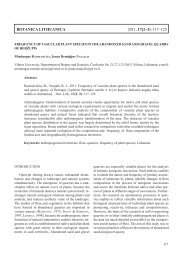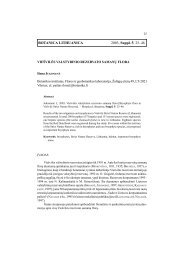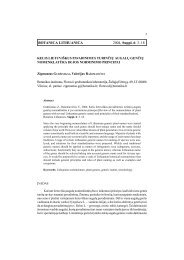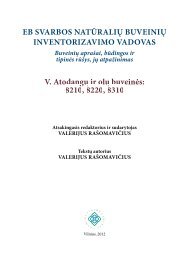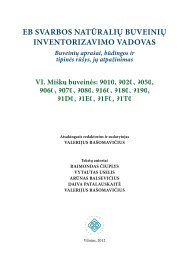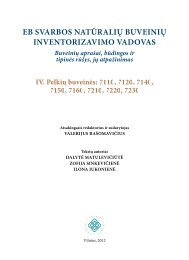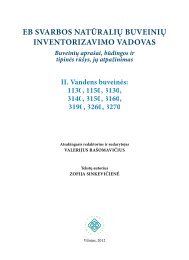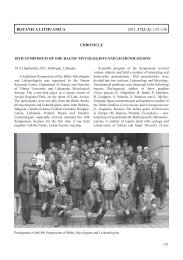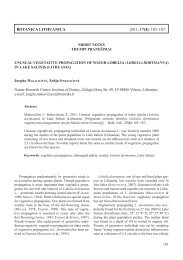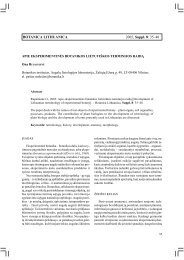FUNGI AND LICHENS IN THE BALTICS AND BEYOND XVIII ...
FUNGI AND LICHENS IN THE BALTICS AND BEYOND XVIII ...
FUNGI AND LICHENS IN THE BALTICS AND BEYOND XVIII ...
Create successful ePaper yourself
Turn your PDF publications into a flip-book with our unique Google optimized e-Paper software.
LICHEN STUDIES ON KARELIAN ISTHMUS (LEN<strong>IN</strong>GRAD REGION, RUSSIA) –<br />
HISTORY <strong>AND</strong> <strong>THE</strong> PRESENT SITUATION<br />
I. S. STEPANCHIKOVA, D. E.HIMELBRANT,<br />
E. S. KUZNETSOVA<br />
Department of Botany, St. Petersburg State University, Universitetskaya Emb. 7/9, 199034 St.<br />
Petersburg, Russia<br />
Laboratory of Lichenology and Bryology, Komarov Botanical Institute of RAS, Prof. Popov<br />
Str. 2, 197376 St. Petersburg, Russia<br />
E-mails: stepa_ir@mail.ru, d_brant@mail.ru, igel_kuzn@mail.ru<br />
Karelian isthmus is located in the north-western Leningrad Region between Gulf of<br />
Finland and Ladoga Lake and has a total area of ca. 15 000 km 2 . It is covered with coniferous<br />
and mixed forests, broad-leaved trees are relatively rare. The area includes many lakes and<br />
rivers. This land has been populated for a long time, so it is rich in settlements and<br />
agricultural lands, many of them abandoned. In different historical periods the isthmus<br />
belonged to Sweden, Finland, USSR and Russia.<br />
The lichen investigations on the Karelian isthmus can be divided into four periods.<br />
The first (1799–1918) is an initial period which begins from Christian Steven’s and William<br />
Nylander’s collections. The second (1918–1945) is a period of active work of Finnish and<br />
Soviet lichenologists on different sides of the Soviet-Finnish border. The third (1945–1992) is<br />
a period of Soviet studies. Considerable part of the area for a long time after the World War II<br />
was closed (as military zone), therefore not much lichen material was collected. The forth<br />
period (1992–nowadays) is characterized by intensive studies: after the Perestroika the<br />
Russian-Finnish border became not so insuperable, and this gave rise to the international<br />
scientific collaboration. During the last decade the environmental activity in Leningrad<br />
Region has developed, and the biodiversity studies have been conducted within the protected<br />
area management.<br />
During the critical revision of the herbaria (H, LE, LECB) in 2007–2011 we found<br />
materials by more than 60 collectors from Karelian isthmus. As a result, ca. 560 species of<br />
lichens and lichenicolous fungi were listed; significant part of these species (about 50) was<br />
found only as additional to the main species in the envelopes (not mentioned on the labels).<br />
Our own collections (2004–2011), mostly from the western part of the Karelian isthmus,<br />
include 375 species. Altogether ca. 650 species are known from the Karelian isthmus now,<br />
and the studies are in progress.<br />
<strong>LICHENS</strong> <strong>IN</strong> STREAMS <strong>AND</strong> RIVERS OF ESTONIA<br />
A. SUIJA, M. SCHMEIMANN<br />
Institute of Ecology and Earth Sciences, University of Tartu, Lai Str. 40, EE51005 Tartu,<br />
Estonia<br />
E-mails: ave.suija@ut.ee, merje.s@gmail.com<br />
Lichens can occur in various extreme habitats including inundated stones and treeroots<br />
in freshwater. This small, highly specialized group of lichens include representatives<br />
mainly of Verrucariaceae, Lichinaceae, Hymeneliaceae. There are about 250 species



